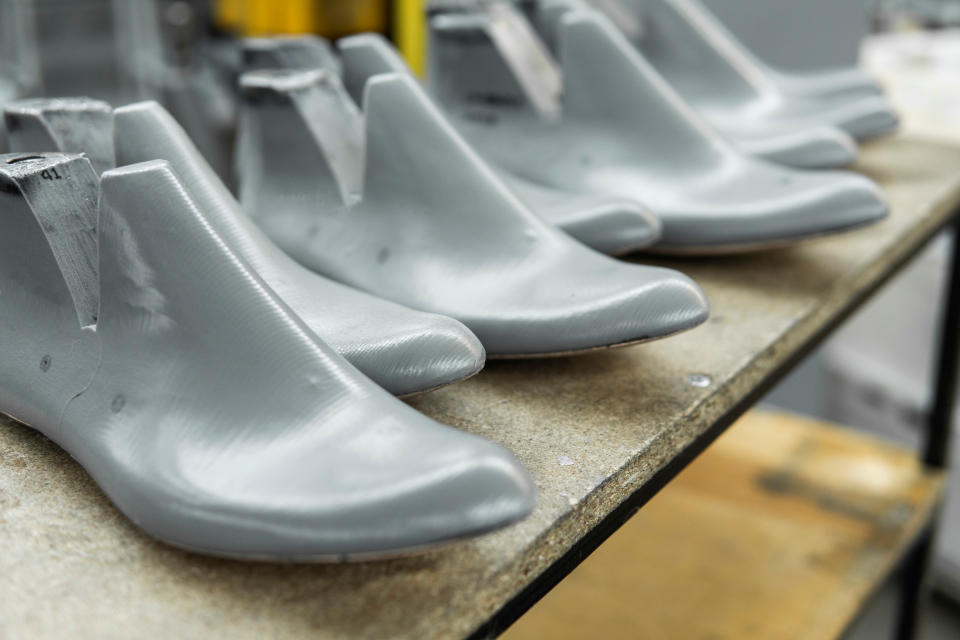Every Aspiring Shoe Designer Should Have This Quality, According to Industry Experts

Click here to read the full article.
For any student with their sights set on shoe design, Keanan Duffty has a key piece of advice: It’s all about a burning passion. “Someone could look at [the career] and see an element of glamour or financial reward, but there are bright times and dark times,” said Duffty, the founding director of masters and conventional studies for fashion management at New York’s Parsons School of Design. “So the No. 1 thing I ask students applying for any program is, ‘Is this live or die for you?’” If the answer is a resounding yes, there are other important factors to consider:
Choose The Right School
Natelle Baddeley, SVP of design, merchandising and product development strategy for Caleres Inc., recognizes that selecting a school or design program can be daunting. She recommends focusing on the right program for you, versus what might be considered the best. Being prepared, even as early as high school, can give aspiring shoe designers a head start.
More from Footwear News
Pensole Academy Partners With Historically Black Colleges to Develop Talent for Footwear & Apparel
Pensole and Yellowbrick Partner to Educate Next Generation of Shoe and Apparel Leaders
“Do your research,” Baddeley said. “Explore different schools and programs that are most interesting, appropriate and affordable for you. Visit the campus, talk to students and faculty. A high-quality curriculum, experienced full-time faculty and successful graduates are all things to look for and consider when making your decision.”
According to experts, another crucial decision early on is to choose a focus within the industry: athletic or fashion. Duffty said that choice will line up with a student’s ultimate goal, whether or not it changes.
Take for example D’Wayne Edwards, one of the youngest design directors in Nike’s history, who found a parallel passion for mentoring others. He launched the Pensole School of Footwear Design through the University of Oregon in 2010 and left Nike one year later to grow the program. He said athletic and fashion are two very different educational tracks, and Pensole takes the untraditional route of providing students with the tools they need to break into footwear design, working in partnership with many of the top brands and training and developing students to be directly pipelined into those organizations. “We help the kids understand what their process should look like by every month, updating with new techniques and new conversations around creativity and inspiration,” Edwards said.

Make the Most of Your Education
During schooling, finding an entry-level job in a shoe store or with a footwear designer can be a powerful learning opportunity outside of the classroom, said Barbara Bundy, VP of education at Los Angeles’ FIDM/Fashion Institute of Design & Merchandising. “Working in a shoe repair store is also a valuable experience. You gain knowledge of the technical aspect of shoe design.”
Baddeley encourages students to pursue internships — the earlier, the better — because they provide hands-on work experience and information that can help inform your career decisions in the future. “If you can afford it, don’t be afraid to take an unpaid internship,” she said. “The experience and resume building you will gain will be invaluable — and of course, it will also provide you with additional network contacts.” Volunteering is another great way to broaden your network and connect with professionals, she added.
At Parsons, students can find mentors as part of the fashion management program. Through “Meet the Mentors,” the school connects students with industry leaders who remain available to provide advice over the course of the year. “All of our students have an opportunity to be mentored by someone who is a successful leader,” Duffty explained. “They may not necessarily be in the footwear industry — it could be a completely different sector — but that can add a fresh approach to students’ understanding of the industry and how they can actually evolve in it.”
Beyond the knowledgeable faculty at Parsons, who hail directly from footwear, fashion or related creative industries, the school also fosters partnerships that provides students with a larger scope of the industry they aspire to work in, according to Jane Francis, assistant professor of BFA Fashion at Parsons’ School of Fashion. The team recently completed a project with Vans in California. “We’re a creative incubator within education, and we are asking our students to think very creatively and experimentally about what the future could look like, particularly from their generational perspective.”

Understand What Companies Want
Talent is always the equalizer — it’s non-negotiable, Edwards noted. “Where it fluctuates is when one student has passion and a burning desire to create. while the other student might be more complacent but more talented. Most companies will go with the person who is slightly less talented but has passion and drive.”
Edwards said he is also seeing a greater emphasis on individual personalities. “That’s becoming equally as valuable as the talent side of it, especially as more companies assimilate these teams of people within their creative organizations. They want to create healthy team environments and a healthy culture. Who you are and what you do with those skills is definitely the differentiation between one candidate and another.”
Caleres’ Baddeley said that beyond passion, there is also a shared curiosity in all of the company’s associates. “We want to hire life-long learners. A flair for fashion, a solid grasp of design principles related to color, balance and line, and an eye for aesthetic detail are essential to become a shoe designer,” she said. The ability to not only understand the target consumer but truly get inside their head is also critical in order to design shoes that’ll be essential to their lifestyle, she added.
Along with that, a good designer, according to Duffty, can provide a new context or present something that already exists and make it fresh. “We’re in a moment of culture now where many iterations of footwear have been done, but it’s re-contextualizing something in a new way that can link to what seems like an original thought or concept. That should be the goal of any designer.”
Of paramount importance — as in any industry — is understanding the macro and micro trends that are happening, both locally and globally, Duffty stressed. “It’s important for students to be aware of where the world is going, not just within footwear design, but what’s happening in general trends in popular culture, lifestyle, diversity of climates, environmental factors, production and the making of shoes. We keep abreast of the big developments because that can be an idea for a business model or a potential employer.”
Paula Williamson-Reid, president of Reid & Company Executive Search, encourages designers to build a solid track record early on in their career. Employers are looking for candidates with fresh ideas, but they have to be commercially viable. And what really matters, especially for veteran designers considering a career move, is how you present your ideas.
“You need to present thought processes in a clear, cohesive and professional way. You need to be able to walk through how you came to your conclusion,” she said. “Also, being able to articulate and connect to a brand’s DNA is critical. You have to show a level of versatility and understanding of how a trend may apply to a specific brand. It’s about presenting those trends in a way that applies to the brand you’re interviewing for.”
Be Forward-Thinking
Along with major changes in the industry comes the rapid development of technology, Baddeley said. Companies and designers no longer rely solely on sketches because there are continual advancements in the software programs available to them, as well as the emergence of 3D printing.
“The fundamental skills are the same, but how we accomplish our work continues to evolve and change,” she explained. “In addition, consumer expectations for speed continue to accelerate. She wants the latest trends now, so being able to react quickly to trends and what’s selling is more important than ever.”
All of the experts agree that sustainability, transparency, diversity and social responsibility are hot-button issues worldwide. “These aren’t trends,” said Duffty, “but hopefully shifts in human psychology that we’re looking to do in a better way.”
Want more?
3 Biggest Mistakes New Shoe Designers Make
4 Brand-Building Tips for New Shoe Designers
Meet the Up-and-Coming Shoe Designers Changing the Game in 2019
Best of Footwear News
Sign up for FN's Newsletter. For the latest news, follow us on Facebook, Twitter, and Instagram.

